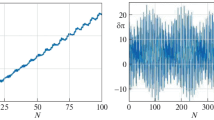Abstract
We consider the dynamical evolution of planetary systems whose structure is nearly circular and coplanar. The analysis is performed by the Hori–Deprit averaging method within the theory of the first order in planetary masses. A convenient set of canonical elements and a rarely employed variety of astrocentric coordinates are used to derive the equations of motion. Owing to the use of the chosen system of canonical elements, the expansions of the right-hand sides of the averaged equations contain a relatively small number of terms. Compared to other widespread coordinate systems, the astrocentric coordinates used by us allow a more convenient representation of the disturbing function to be obtained and do not require its expansion into a series in powers of a small parameter. On time scales \({\sim}10^{5}{-}10^{7}\) years we have studied the long-term evolution of the planetary systems HD 12661, \(\upsilon\) Andromedae, and some model systems by numerical integration of the averaged equations. Possible secular resonances have been revealed in the systems considered.










Similar content being viewed by others
Notes
Recall that a particular solution of a system of ordinary differential equations is called Lagrange-stable if it remains definite and uniformly bounded at all \(t\geqslant t_{0}\), where \(t_{0}\) is the initial time. The Lagrangian triangular solutions in the general three-body problem can serve as an example of a Lagrange-stable system. A precise definition of the Lagrange stability can be found in the textbooks by Grebenikov (1976) and Demidovich (1967).
Strictly speaking, small denominators appear even in the first order, see the first paragraph of Section 5.
By the two-planet Sun–Jupiter–Saturn system Kuznetsov and Kholshevnikov (2006) mean a model two-planet system in which two planets with the masses and orbital parameters of Jupiter and Saturn revolve around a solar-mass star.
REFERENCES
R. V. Baluev, Celest. Mech. Dyn. Astron. 111, 235 (2011).
N. N. Bogolyubov and Yu. A. Mitropol’skii, Asymptotic Methods in the Theory of Nonlinear Oscillations (Gordon and Breach, London, 1961; Nauka, Moscow, 1974).
V. V. Chazov, Solar System. Res. 47, 99 (2013).
B. Cordani, Celest. Mech. Dyn. Astron. 89, 165 (2004).
B. P. Demidovich, Lectures on the Mathematical Theory of Stability (Nauka, Moscow, 1967) [in Russian].
G. E. O. Giacaglia, Perturbation Methods in Non-linear Systems (Springer, New York, 1972).
E. A. Grebenikov, in Reference Book on Celestial Mechanics and Astrodynamics Ed. by G. N. Duboshin (Nauka, Moscow, 1976), p. 788 [in Russian].
E. A. Grebenikov, Averaging Method in Applied Problems (Nauka, Moscow, 1986) [in Russian].
E. Hairer, S. Nörsett, and G. Wanner, Solving Ordinary Differential Equations I: Nonstiff Problems (Springer, Berlin, Heidelberg, 1993).
K. V. Kholshevnikov, Asymptotic Methods of Celestial Mechanics (LGU, Leningrad, 1985) [in Russian].
K. V. Kholshevnikov and E. D. Kuznetsov, Celest. Mech. Dynam. Astron. 109, 201 (2011).
K. V. Kholshevnikov, A. V. Greb, and E. D. Kuznetsov, Solar System. Res. 35, 243 (2001).
K. V. Kholshevnikov, A. V. Greb, and E. D. Kuznetsov, Solar System. Res. 36, 68 (2002).
O. M. Kochetova, V. B. Kuznetsov, Yu. D. Medvedev, Yu. A. Chernetenko, and V. A. Shor, Ephemerides of Minor Planets for 2020 (IAA RAS, St. Petersburg, 2019).
G. A. Krasinskiy, in Minor Planets, Collection of Articles, Ed. by N. S. Samoilova-Yakhontova (Nauka, Moscow, 1973), p. 81 [in Russian].
E. D. Kuznetsov and K. V. Kholshevnikov, Solar System. Res. 40, 239 (2006).
E. D. Kuznetsov and K. V. Kholshevnikov, Solar System. Res. 43, 220 (2009).
J. Laskar, Astron. Astrophys. 287, L9 (1994).
J. Laskar and P. Robutel, Celest. Mech. Dynam. Astron. 62, 193 (1995).
M. H. Lee and S. J. Peale, Astrophys. J. 592, 1201 (2003).
A.-S. Libert and N. Delsate, Mon. Not. R. Astron. Soc. 422, 2725 (2012).
A.-S. Libert and M. Sansottera, Celest. Mech. Dynam. Astron. 117, 149 (2013).
A. P. Markeev, Libration Points in Celestial Mechanics and Cosmodynamics (Nauka, Moscow, 1978) [in Russian].
D. V. Mikryukov, Astron. Lett. 42, 555 (2016).
D. V. Mikryukov, Astron. Lett. 44, 337 (2018).
D. V. Mikryukov and K. V. Kholshevnikov, Astron. Lett. 42, 268 (2016).
Yu. A. Mitropol’skii, Averaging Method in Nonlinear Mechanics (Naukova Dumka, Kiev, 1971) [in Russian].
N. N. Moiseev, Asymptotic Methods of Nonlinear Mechanics (Nauka, Moscow, 1969) [in Russian].
A. Morbidelli, Modern Celestial Mechanics: Aspects of Solar System Dynamics (Taylor Francis, London, 2002).
C. Murray and S. Dermott, Solar System Dynamics (Cambridge Univ. Press, Cambridge, 2000).
A. H. Nayfeh, Perturbation Methods (Wiley, New York, Chichester etc., 2000).
A. S. Perminov and E. D. Kuznetsov, Solar System. Res. 49, 430 (2015).
H. Poincaré, Leçons de Mécanique Céleste, tome I (Gauthier-Villars, Paris, 1905).
P. Robutel, L. Niederman, and A. Pousse, Comp. Appl. Math. 35, 675 (2016).
A. Rodríguez and T. Gallardo, Astrophys. J. 628, 1006 (2005).
M. Sansottera and A.-S. Libert, Celest. Mech. Dynam. Astron. 131, 38 (2019).
I. I. Shevchenko, The Lidov-Kozai Effect—Applications in Exoplanet Research and Dynamical Astronomy (Springer, Switzerland, 2017).
M. A. Vashkov’yak, S. N. Vashkov’yak, and N. V. Emel’yanov, Solar Syst. Res. 49, 191 (2015).
V. M. Volosov and B. I. Morgunov, Averaging Method in the Theory of Nonlinear Oscillatory Systems (MGU, Moscow, 1971) [in Russian].
A. Wintner, The Analytical Foundations of Celestial Mechanics (Princeton Univ. Press, Princeton, 1941).
ACKNOWLEDGMENTS
I thank K.V. Kholshevnikov for supervising the work and V.S. Shaidulin for his help in preparing the figures. I also express my gratitude to the anonymous referee for the fruitful comments and useful suggestions on the manuscript. All our computations were performed using the equipment of the Computing Center in the scientific park of the St. Petersburg State University. This work was financially supported by the Russian Science Foundation (project no. 19-72-10023).
Author information
Authors and Affiliations
Corresponding author
Additional information
Translated by V. Astakhov
Rights and permissions
About this article
Cite this article
Mikryukov, D.V. Analysis of the Stability of a Planetary System on Cosmogonic Time Scales. Astron. Lett. 46, 344–358 (2020). https://doi.org/10.1134/S1063773720050059
Received:
Revised:
Accepted:
Published:
Issue Date:
DOI: https://doi.org/10.1134/S1063773720050059




